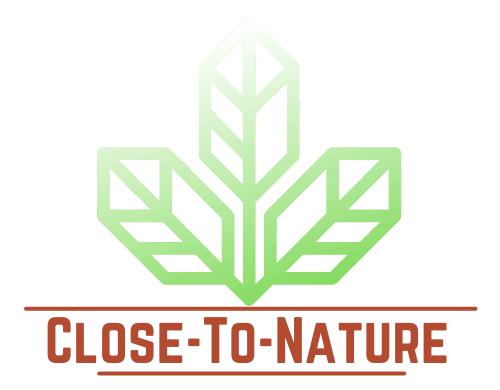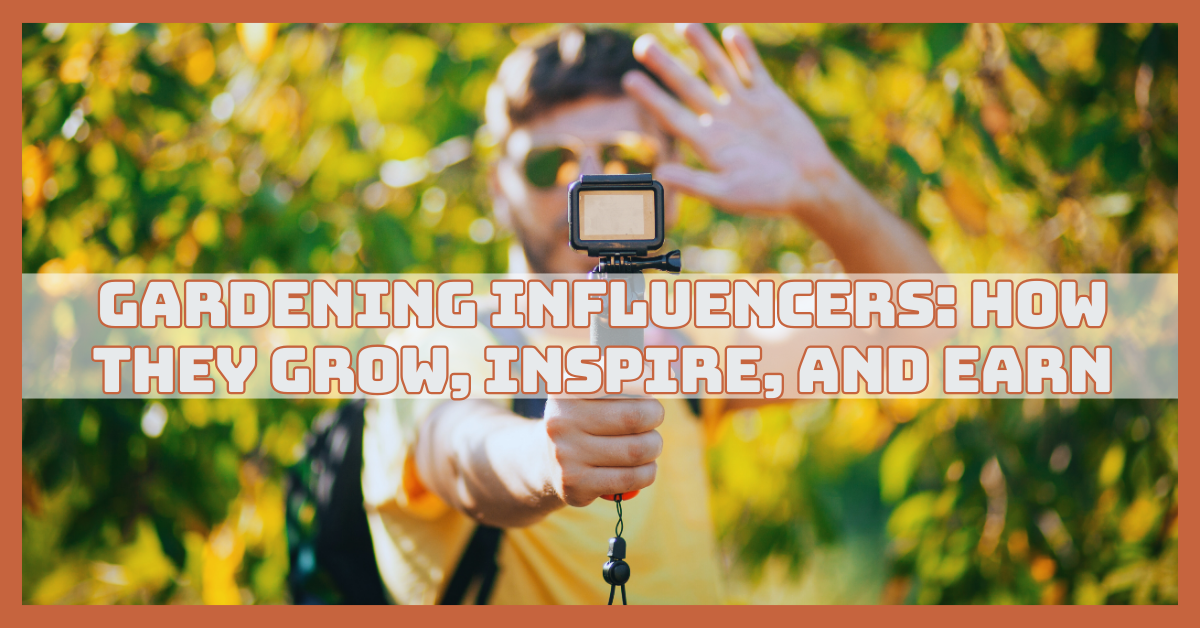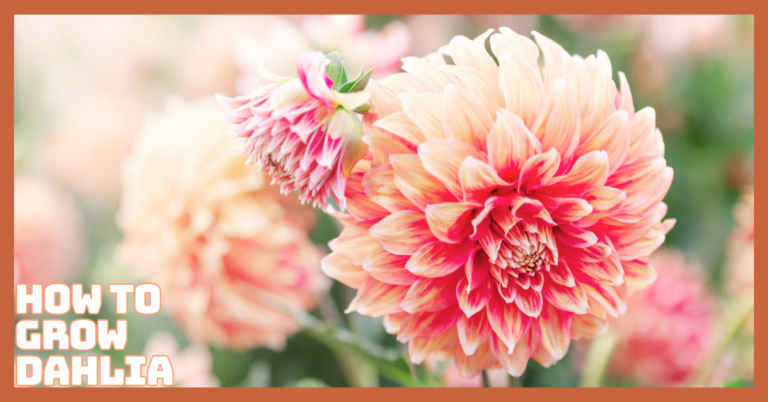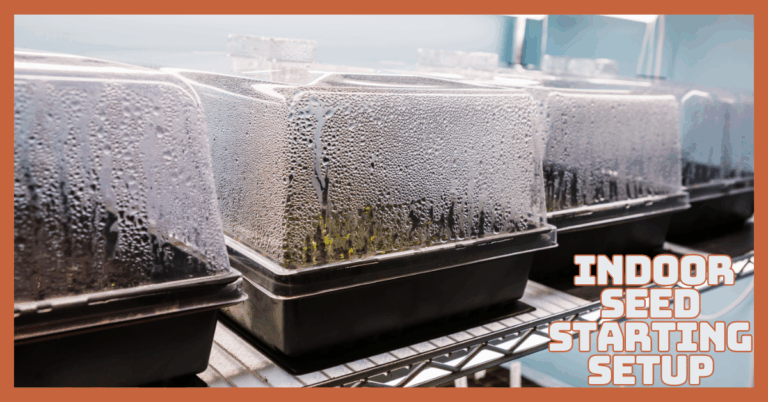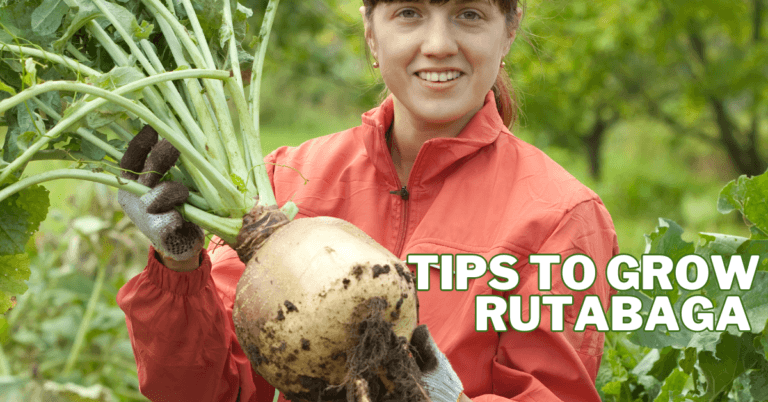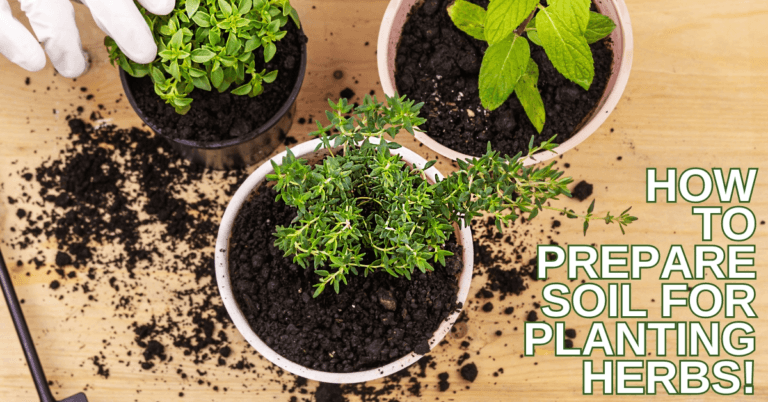Gardening Influencers: How They Grow, Inspire, And Earn
Gardening influencers have transformed the way we connect with nature, turning simple plant care into a source of inspiration and creativity.
Through social media, blogs, and videos, these influencers share tips, tricks, and personal stories that motivate others to start their own gardens.
Beyond inspiring, they also discover ways to earn from their passion, proving that gardening isn’t just a hobby—it’s a growing online movement.
What Is A Gardening Influencer?
A gardening influencer is someone who shares their passion for plants, gardening, and sustainable living with an online audience.
They use platforms like Instagram, YouTube, TikTok, and blogs to create engaging content about growing flowers, vegetables, or indoor plants.
Unlike traditional gardening experts, influencers connect with people in a personal, relatable way by documenting their own gardening journey, including successes and failures.
Their content often includes tutorials, product reviews, garden tours, and seasonal tips. Gardening influencers inspire, educate, and build communities of plant lovers, while also turning their knowledge into income through brand partnerships and affiliate marketing.
What Kind Of Content Gardening Influencers Create
Gardening influencers inspire, educate, and entertain plant lovers worldwide. Through tutorials, tours, and tips, they share passion, creativity, and expertise while building communities and earning income from products and partnerships.
1. How-To Tutorials
How-to tutorials are among the most potent content types for gardening influencers. They walk audiences step-by-step through tasks like planting tomatoes, pruning roses, or starting compost bins.
The process involves recording videos or writing blogs with clear instructions, photos, and personal tips. Tutorials help build authority and trust because they solve real problems.
Influencers can earn through affiliate marketing by linking to tools, soil mixes, fertilizers, or gardening books they recommend in their tutorials.
For example, a video on “How to Grow Basil Indoors” can include affiliate links to grow lights, pots, and seed suppliers.
2. Garden Tours
Garden tours showcase the beauty of an influencer’s personal space—whether a backyard, greenhouse, or balcony garden.
The process usually involves filming a walk-through, highlighting plant varieties, design ideas, and seasonal progress. Garden tours feel authentic and allow audiences to see what’s possible in different spaces.
They inspire creativity and build deeper engagement. Earning opportunities come through sponsored content, where brands pay influencers to feature planters, garden décor, or eco-friendly furniture.
They can also include affiliate links in video descriptions or blog posts to products like garden benches, raised beds, or decorative lighting seen in the tour.
3. Product Reviews
Product reviews help followers decide which gardening products are worth buying. The process involves testing tools, soil types, fertilizers, or tech gadgets like moisture meters, then giving an honest opinion.
This builds credibility because audiences value genuine recommendations. Reviews can be blog-based for SEO or video-based for engagement.
Earning potential is high with affiliate programs. By linking to reviewed items on Amazon, garden supply stores, or direct affiliate networks, influencers earn a commission on every sale.
Partnerships with brands for sponsored reviews also generate income, making product reviews one of the most profitable content types.
4. DIY Gardening Projects
DIY gardening projects are creative, hands-on ideas that inspire audiences to build or craft something themselves. The process might include step-by-step instructions for making vertical gardens, recycled planters, or homemade compost bins.
This content is highly shareable because it combines creativity, sustainability, and budget-friendly solutions. Influencers can monetize DIY projects by linking to materials and tools needed for the project through affiliate programs.
For example, a video on building a raised bed could include affiliate links for wood, soil, or screws. Additionally, influencers can bundle several DIY ideas into paid e-books or downloadable guides.
5. Seasonal Gardening Tips
Seasonal tips are practical, time-sensitive posts that help audiences succeed throughout the year. The process involves sharing guidance on planting schedules, pest control, harvesting, or protecting plants during extreme weather.
These posts show influencers as reliable sources of ongoing advice. Earning opportunities come from promoting seasonal products like fertilizers, seeds, mulch, or frost covers.
For example, a blog about “Spring Planting Essentials” can link to affiliate products such as seed packets or gardening gloves.
Seasonal guides can also be repurposed into newsletters or paid workshops, creating multiple income streams from one piece of content.
6. Inspirational And Lifestyle Posts
Not every post has to be technical—many influencers share lifestyle-oriented or motivational content. The process includes beautiful garden photography, personal reflections, or quotes about nature and mindfulness.
These posts connect emotionally with audiences and build brand identity. While inspiration alone doesn’t sell products directly, influencers can monetize by weaving in subtle promotions.
For example, a calming Instagram reel of a blooming garden could feature affiliate links in the caption for the camera used, gardening books for beginners, or even eco-friendly clothing. Lifestyle branding also attracts sponsorships from wellness, home décor, and eco-living companies.
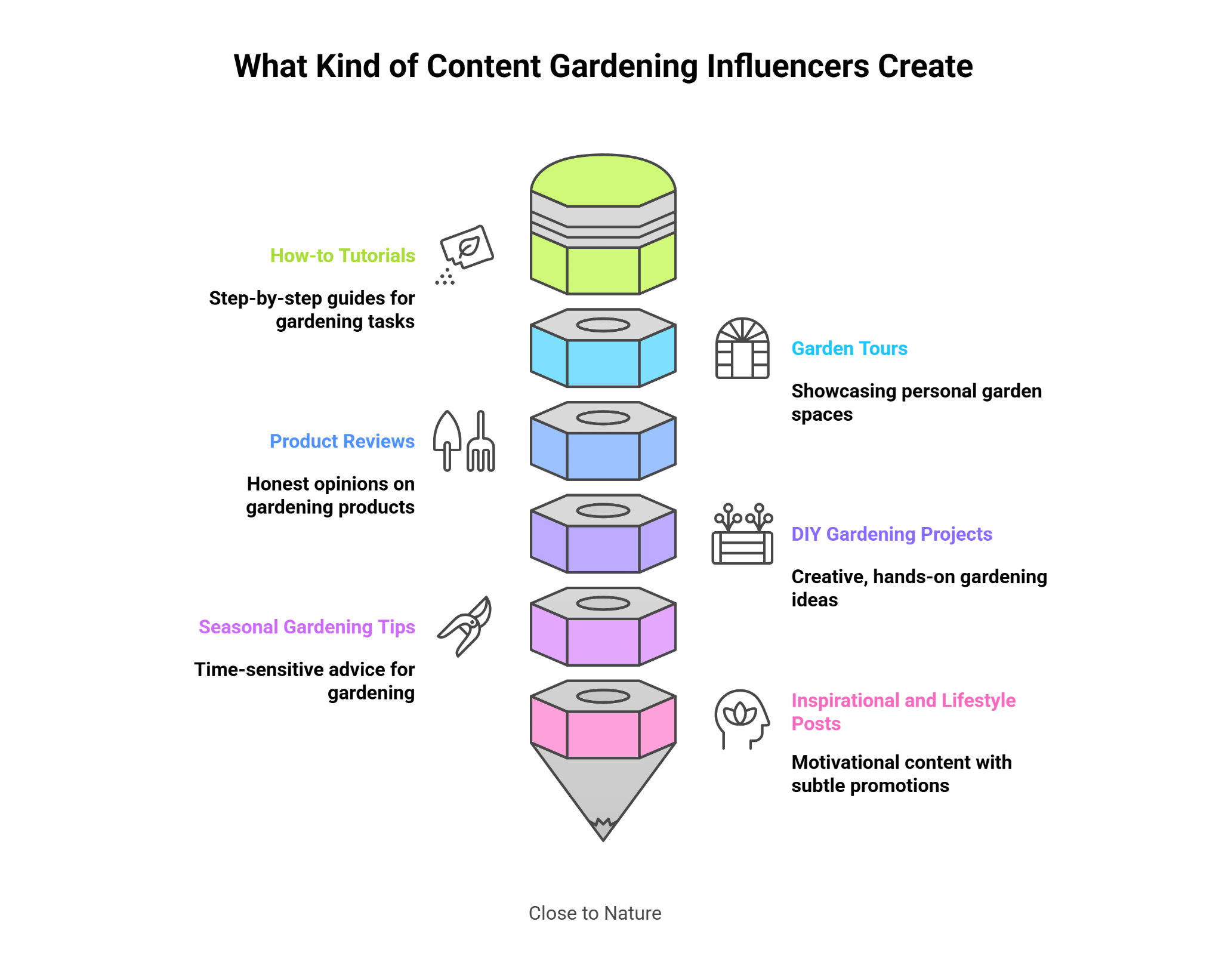
Getting Started As A Gardening Influencer
Starting as a gardening influencer combines passion and strategy. By sharing tips, tutorials, and DIY projects on a website and social media, you can inspire, engage, and earn income effectively.
1. Pick Your Platform
While social media is essential, a website becomes the heart of your gardening influence. It’s where your tutorials, garden tours, and seasonal tips all come together in one place.
Many gardening creators use beginner-friendly platforms like Wealthy Affiliate to build their site, write content, and learn the basics of SEO.
What matters most is choosing a platform that feels simple, supportive, and helps you share your gardening journey with clarity.
Your website becomes your home base — a space you fully control, where readers can return for ongoing inspiration, plant care tips, and your personal gardening insights.
2. Find Your Niche Angle
A website lets you focus on a specific gardening niche and target your audience precisely. The process includes keyword research for your chosen niche (like indoor plants or balcony gardens), creating categories on your site, and writing posts that align with your angle.
Having a niche-focused website helps your content rank on search engines, attracting visitors who are actively searching for information.
Once your audience finds your site valuable, you can monetize through targeted affiliate links, sponsored posts, and downloadable guides. The website becomes your primary asset for long-term growth.
3. Start Creating Consistently
A website makes consistent content creation easier to manage. Use your site to post weekly blogs, photo tutorials, or seasonal guides.
The process involves planning a content calendar, drafting posts, adding images or videos, and publishing with SEO optimization.
Your website allows integration with social media so that posts can be shared automatically. Consistency on your site builds authority and trust, increasing organic traffic.
With a website, you can also include affiliate links naturally in each post, such as links to gardening tools, seeds, or books, turning your consistent content into a steady income stream.
4. Engage With Your Community
Websites offer multiple ways to engage your audience beyond social media. The process includes enabling comments on blog posts, adding contact forms, and creating newsletters for subscribers.
You can host free resources or downloadable guides to encourage email sign-ups. Engaging via your website builds a loyal community that trusts your recommendations. Email lists can be used to promote affiliate products, seasonal guides, or online workshops.
Additionally, a website allows you to create membership areas or exclusive content for fans. Strong engagement on your site ensures followers return regularly and are more likely to buy through affiliate links.
5. Monetize With Affiliate Products
A website is one of the most effective ways to earn through affiliate marketing. Once your gardening posts begin to attract visitors, you can naturally recommend tools, seeds, soil mixes, books, or decor that you genuinely love.
Creating helpful content—like “Top 10 Indoor Gardening Tools” or “Best Compost Bins for Small Spaces”—helps readers make informed choices while supporting your gardening work through small commissions.
🌱 Start Your Gardening Blog Today — Try WA Free (No Credit Card Needed)
Your website also gives you room to place banners, sidebars, or helpful product suggestions that fit your content. With the proper training and tools, your gardening blog can grow into a long-term income stream as your posts continue bringing in readers and clicks over time.
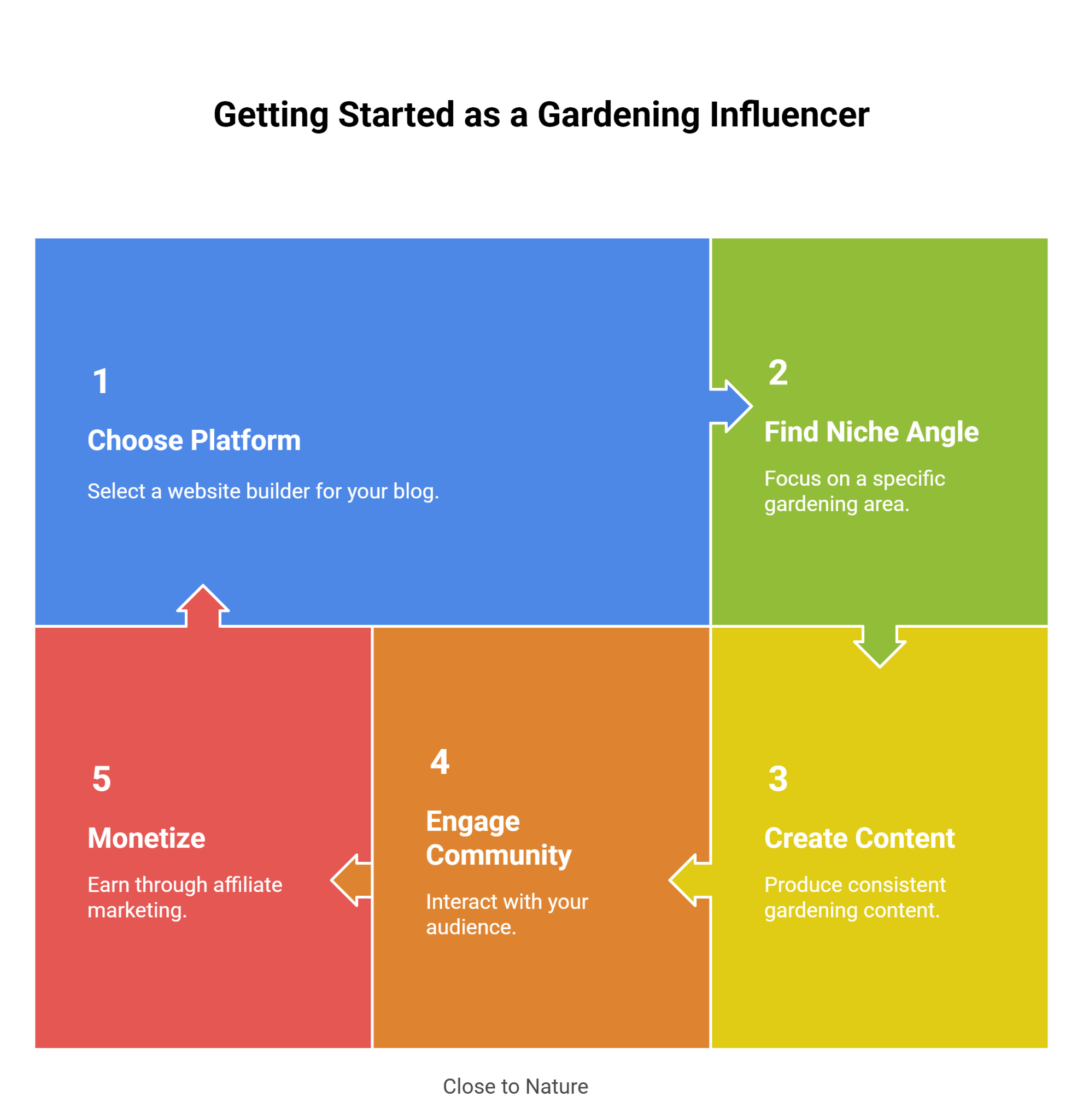
Examples Of Successful Gardening Influencers
Gardening influencers have transformed their passion for plants into thriving careers. Through tutorials, tours, and authentic storytelling, they inspire millions while earning through ads, affiliate links, sponsorships, and product sales.
1. Garden Answer (Laura and Aaron)
Laura and Aaron, creators of Garden Answer, are among the most recognized gardening influencers on YouTube. They post daily tutorials, garden tours, and DIY landscaping projects. Their approachable style and professional-quality videos attract millions of views each month.
Their estimated annual earnings range between $500,000–$1 million, combining YouTube ad revenue, affiliate marketing, and sponsored brand collaborations with companies like Proven Winners.
They also monetize through partnerships with gardening supply brands and by driving traffic to affiliate-linked products in their videos. Their blend of expertise and relatability makes them trusted figures in the gardening community worldwide.
2. Epic Gardening (Kevin Espiritu)
Kevin Espiritu founded Epic Gardening with the mission of making gardening simple for everyone. He shares content on YouTube, Instagram, TikTok, and his blog, covering vegetables, hydroponics, and urban gardening. His estimated annual income exceeds $1 million, thanks to diverse revenue streams.
These include YouTube ads, affiliate marketing, brand sponsorships, and a thriving e-commerce business selling raised beds, seeds, and soil through the Epic Gardening shop.
Kevin also launched a podcast and educational courses, expanding his reach. His success comes from blending helpful tutorials with a clear, approachable teaching style that resonates with beginner gardeners globally.
3. James Prigioni
James Prigioni is a backyard gardener from New Jersey who documents his journey of growing food in a suburban setting.
His YouTube channel shares permaculture practices, garden tours, and organic vegetable growing tips. James’s content is both practical and inspiring, appealing to viewers who want to grow more food at home.
His estimated annual earnings range from $100,000–$300,000, primarily from YouTube ads, affiliate programs linking to seeds and gardening tools, and occasional sponsorships.
His authenticity and focus on food independence have built a loyal community, making him one of the most respected voices in sustainable gardening.
4. Garden Answer Girl (Kelly Norris)
Kelly Norris, often referred to as the Garden Answer Girl, focuses on plant education, landscaping advice, and seasonal gardening tips. She shares informative videos, blog posts, and photography that emphasize plant care and design.
Her estimated earnings are around $80,000–$200,000 annually, coming from affiliate links, sponsored content with garden supply companies, and speaking engagements at gardening events. She also generates income through online courses and digital guides.
Kelly’s content appeals to both beginner and advanced gardeners, blending aesthetics with practical gardening solutions, and her work continues to influence a growing audience of plant lovers.
5. Huw Richards
Huw Richards is a young gardening influencer from the UK who has built a massive following through his focus on sustainable vegetable gardening.
He publishes YouTube tutorials, seasonal planting tips, and budget-friendly gardening hacks. Huw also writes books, adding to his credibility.
His estimated annual income ranges between $150,000–$400,000, earned from YouTube ad revenue, book sales, affiliate marketing, and brand collaborations. Huw’s authenticity and focus on self-sufficiency attract younger audiences eager to try gardening.
His approachable style shows how even small spaces can produce large harvests, inspiring thousands of beginner gardeners globally.
6. Roots and Refuge Farm (Jess Sowards)
Jess Sowards, creator of Roots and Refuge Farm, shares her family’s homesteading and gardening journey on YouTube and Instagram.
She combines tutorials on growing food with heartfelt storytelling about simple living. Jess has built a loyal community of followers who resonate with her authenticity.
Her estimated annual income is $200,000–$500,000, primarily from YouTube ads, affiliate marketing, book sales, and sponsored brand partnerships. She also earns from workshops and events.
Jess’s success lies in her unique ability to combine practical gardening advice with emotional connection, turning her farm lifestyle into a thriving influencer brand.
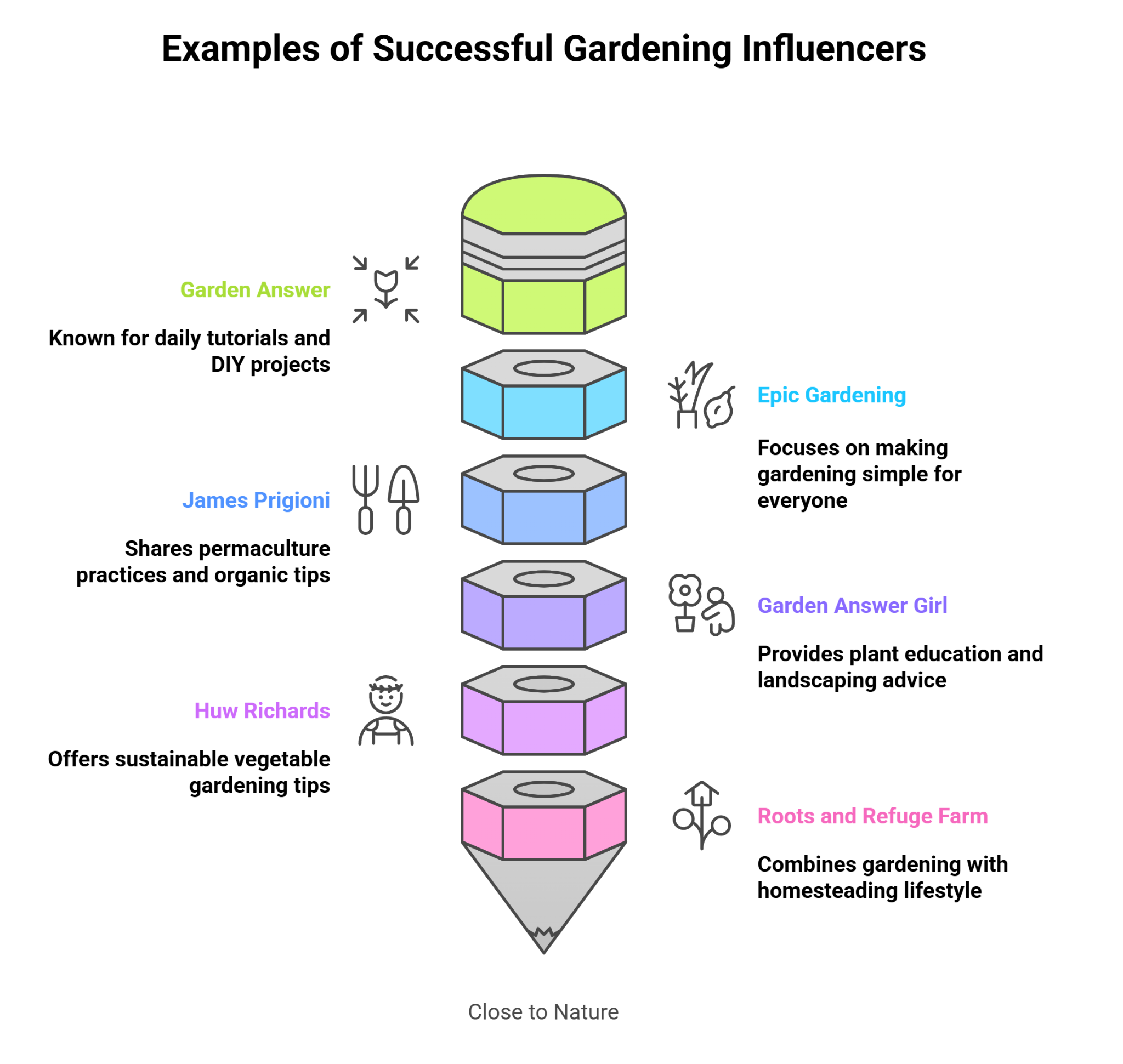
Wealthy Affiliate And Gardening Influencers
Many new gardening influencers wonder how to start earning before they have a large audience. One simple way is to use a platform that teaches you how to build a blog, write useful content, and connect with affiliate programs — something beginner-friendly like Wealthy Affiliate.
Having a central website allows you to share tutorials, garden tours, product reviews, and seasonal tips in one organized place.
As your content grows, your site becomes a long-term asset that continues attracting visitors and generating income through helpful product recommendations.
Here’s how the process usually works:
1. Create a Website with WA
Choose a gardening-related domain name and set up a simple site where all your plant care tips, videos, and tutorials can live. Your website becomes your home base — the place where your audience returns for advice, updates, and inspiration.
2. Write Helpful Posts
Focus on posts that answer real gardening questions, such as:
-
Top 10 Indoor Gardening Tools
-
How to Start a Balcony Garden
-
Beginner-Friendly Herbs to Grow Indoors
Helpful content builds trust and brings steady search traffic.
3. Add Affiliate Links
Once your articles are published, you can add affiliate links for gardening tools, seeds, books, soil mixes, or décor. Placing them gently within your posts helps readers find products you truly recommend.
4. Get Traffic through SEO
Basic SEO helps your posts reach more readers. With time, your how-to guides and tutorials can rank in search engines, bringing consistent visitors who are already looking for gardening solutions.
5. Earn Commissions
When readers click your links and buy, you get paid. When readers click your links and purchase products, you earn commissions.
This allows you to start earning even while your social media audience is still growing — your blog becomes the foundation that supports your long-term income.
FAQs
Q1. Do I Need A Big Following To Become A Gardening Influencer?
Not necessarily. Engagement and quality content matter more than numbers. Micro-influencers with 5k–20k followers often collaborate with brands successfully.
Q2. How Long Does It Take To Grow A Following As A Gardening Influencer?
It varies. With consistent, high-quality content, some influencers see growth in a few months, while others may take a year or more to establish their audience.
Q3. Can Anyone Become A Gardening Influencer?
Yes! Passion, knowledge, and consistency are key. You don’t need formal training, but learning and sharing tips accurately builds trust and credibility.
Q4. How Do Gardening Influencers Engage With Their Audience?
Through comments, live sessions, Q&A posts, giveaways, newsletters, and collaborations. Engaging content encourages followers to interact and share their experiences.
Q5. Are Gardening Influencers Only About Plants?
While plants are central, many integrate lifestyle elements like home décor, sustainability, outdoor living, and wellness to connect with a broader audience.
Q6. Can Gardening Influencers Help Beginners Learn Gardening?
Absolutely. Many provide step-by-step tutorials, plant care guides, and practical tips to help beginners start and maintain their gardens successfully.
Q7. How Do Gardening Influencers Engage With Their Audience?
Through comments, live sessions, Q&A posts, giveaways, newsletters, and collaborations. Engaging content encourages followers to interact and share their experiences.
Q8. Are Gardening Influencers Only About Plants?
While plants are central, many integrate lifestyle elements like home décor, sustainability, outdoor living, and wellness to connect with a broader audience.
Q9. Can Gardening Influencers Help Beginners Learn Gardening?
Absolutely. Many provide step-by-step tutorials, plant care guides, and practical tips to help beginners start and maintain their gardens successfully.
Conclusion
Gardening influencers show us that passion, creativity, and knowledge can bloom into something bigger than just a hobby.
Whether it’s inspiring others, sharing expertise, or turning gardening into a source of income, their journey reminds us that growth—both in plants and in life—is always possible.
Start your own gardening adventure today and see how it can transform your world, one seed at a time.
I trust you enjoyed this article on Gardening Influencers: How They Grow, Inspire, and Earn. Please stay tuned for more inspiring guides, helpful tips, and ideas to help you live closer to nature every day.
Take care!
— JeannetteZ
💬 Your Opinion Is Important To Me
Do you have thoughts, ideas, or questions? I’d love to hear from you. Please leave your comments below or email me directly at Jeannette@Close-To-Nature.org.
📚 More Nature-Inspired Reads
Explore more ways to connect with nature, nurture your pets, and live in harmony with the world around you 🌿
